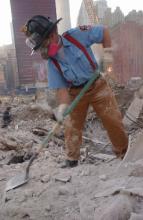Three large cohort studies examining health issues in World Trade Center rescuers paint a mixed picture, with disturbingly high rates of physical and mental disorders but a paradoxically low all-cause mortality rate thus far, compared with the general New York City population.
More than 50,000 people participated in rescue and recovery work following the 2001 attacks on the World Trade Center a decade ago. A cohort study involving 27,449 of those people who are enrolled in the federally funded WTC Screening, Monitoring, and Treatment Program showed a 9-year cumulative incidence of 28% for asthma, 42% for sinusitis, 39% for gastroesophageal reflux disease (GERD), and 42% for spirometric abnormalities.
Among nonpolice enrollees, the cumulative incidence of depression was 28%, post-traumatic stress disorder (PTSD) 32%, and panic disorder 21%. Police officers had rates of those mental disorders that were only one-third to one-fourth of those rates.
Comorbidities were common among the program enrollees, whose median age was 38 years. Overall, 8.6% of rescue and recovery workers had the triad of physician-diagnosed asthma, sinusitis, and GERD. Another 18% had two of the three diseases. Between 40% and 50% of workers with one or more of those medical diseases were also diagnosed with depression, PTSD, and/or panic disorder. Conversely, nearly 70% of workers with one or more of the psychiatric diagnoses also had asthma, GERD, and/or sinusitis.
"Our findings show a substantial burden of persistent physical and mental disorders in rescue and recovery workers who rushed to the site of the WTC and labored there for weeks and months 10 years ago. Many of these individuals now suffer from multiple health problems," concluded Dr. Juan P. Wisnivesky, of the Mount Sinai School of Medicine, New York, and his associates (Lancet 2011;378:888-97).
Mortality Lower Than Expected. Also appearing in the Lancet’s special 9/11 issue was a study demonstrating that all-cause mortality during 2003-2009 in 13,337 rescue and recovery workers was 55% lower than expected, based upon comparison to a demographically similar New York City general population. Mortality in 28,593 bystanders – nonparticipants in the rescue and recovery work who lived or worked in lower Manhattan – was 39% lower than expected. Both reductions were significant.
Among rescue and recovery workers, higher levels of exposure to toxic dust and other WTC-related hazards were not significantly associated with greater all-cause mortality, said Dr. Hannah T. Jordan, of the New York City Department of Health and Mental Hygiene, and her associates (Lancet 2011;378:879-87).
The investigators observed that the reduced mortality in the WTC-exposed population could be explained by a combination of bias due to the healthy worker effect and insufficiently long follow-up to date. Continued monitoring of all-cause and disease-specific mortality is a must, they added.
Cancer Rates and Firefighters. In a third post-9/11 study, cancer rates among 9,853 male firefighters with WTC exposure were 10% greater during the first 7 years of follow-up than in a demographically similar control group obtained from the National Cancer Institute’s Surveillance, Epidemiology and End Results (SEER) database.
It’s a modest increase and a relatively short duration of follow-up for cancer outcomes. Moreover, the observed excess in cancers wasn’t limited to specific organ types. In fact, there was an unanticipated 58% lower rate of lung cancer in the WTC-exposed firefighters than in controls, according to Rachel Zeig-Owens, of the department of medicine at Montefiore Medical Center, Bronx, N.Y., and her associates (Lancet 2011;378: 898-905). For all those reasons, the investigators said their findings should be interpreted with caution.
Nonetheless, those data warrant incorporating coverage for cancer in the federally funded medical follow-up of those workers, Dr. James M. Melius said in an interview.
"I do think that the increase in cancer is real. I think that this study, along with what we know about exposures at the WTC – high exposures to multiple carcinogens in a population with an already high disease burden – helps to make the case that cancer should be added to the list," said Dr. Melius of the New York State Laborers’ Health Fund.
"This needs to be viewed in the context that the government should have done more to protect these workers and didn’t, that making them wait 20 or 30 years until definitive studies are done is unfair, and that delay leaves them vulnerable to the economic and personal difficulties from high medical costs – even with insurance – that people in our country often experience," Dr. Melius added.


